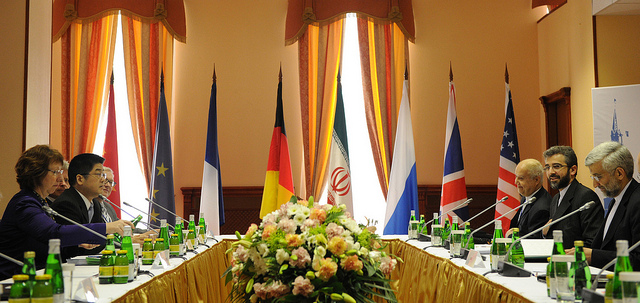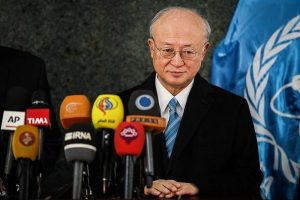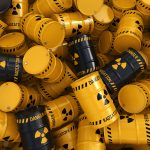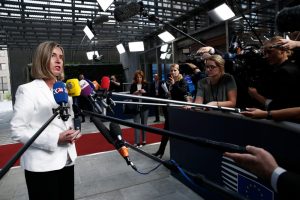It is expected that the six world powers negotiating group (the P5+1) will once again meet this month at various diplomatic levels with Iranian representatives to resolve fears that Iran could decide to divert its civilian nuclear program toward military use. Little has been agreed upon in past sessions and optimism for the next meeting is modest. The allied group’s most recent position has called for the ending of 20 percent uranium enrichment; the shipment abroad of 20 percent enriched uranium; the closure of Fordow, an underground enrichment center near Qom; and a halt to lower-grade enrichment. Iran has insisted that it has the right to enrich uranium under the Nuclear Non-Proliferation Treaty (NPT) for peaceful purposes and, in effect, that its concerns about sanctions must be addressed.
American press and government attention to Iran’s extensive nuclear program is concentrated on its potential diversion of nuclear material toward military purposes. Often ignored in public discussions about Iran’s nuclear ambitions is that its interest in nuclear power and related medicinal use spans over 40 years. In the 1980s, the Shah developed the thesis that petroleum should be used for dozens of potential products and not wasted on power production. At that time, he set a target of 20,000 megawatts (mg) of power by ten nuclear reactors to be designed and erected by engineering firms from the US, France and Germany. The Germans were the only country that got to the actual construction phase of Iran’s first power reactor in the city of Bushehr. The US and Iran had to reach agreement on a new treaty on the peaceful uses of nuclear energy before contracts could be signed and the long negotiations were held up by the Shah’s insistence that the treaty provide for Iran’s right to the entire nuclear process from enrichment to reprocessing. A compromise was reached and the agreement was initialed in the summer of 1978, but the revolution intervened before it could be submitted to the Senate for ratification.
In the 1977-78 period, the Shah also instructed his staff to calculate what resources, human and other, would be needed if at some point Iran decided to have a military nuclear program. The entire program was then set aside early in the revolutionary period by the Iranian government and Western governments withdrew their interests in cooperation, including Germany.
During the late 1980s or early 1990s, Iran’s new Islamic government directly or indirectly drew upon plans laid down by the monarchy and assessed its future power needs. Like the monarchy it had worked to overthrow, Iran’s current government opted for 20,000 mg of nuclear origin to be completed in the third decade of 2000. In this period, the Rafsanjani and Khatami governments, like the Shah before them, also apparently authorized research and experimentation for possible military uses. It is these activities that continue to concern the International Atomic Energy Agency (IAEA) and Western governments even though Iran has steadily denied engaging in nuclear activities that are geared toward military purposes. The American intelligence community has officially concluded that in fact, Iran halted suspicious actions in 2003 and no other state has asserted that it has convincing evidence to the contrary.
Now, more than 40 years after the first expression of interest in nuclear power, Iran has in operation only Bushehr, a 1,000 mg pressurized water reactor, that the Russians took over from the canceled German contract. Power reactors require the enrichment of large amounts of uranium ore to a level of 3.5% to 5%, or Low-enriched Uranium (LEU), and further separative work to a form appropriate for reactor fuel. Reactors like Bushehr require roughly 26 tonnes of LEU as yearly fuel and several times that for total start-up requirements. As part of the construction contract, the Russians have provided a total of 85 tonnes of LEU and have to maintain control of the irradiated fuel. Bushehr has the capacity to supply 2% of the country’s electricity needs.
Iranian authorities expect to complete the Arak heavy water plant in 2013-2014. The reactor will create 40 mg of power and 10-12 kilos of plutonium per year. Officials in Tehran have claimed that the plutonium will be used for research and medicinal isotopes. Outside observers are particularly concerned that at some point in the future the plutonium could be used to build at least two nuclear explosives yearly if the plutonium is separated form the fuel. North Korea, Israel, India, and Pakistan used plutonium for their nuclear bombs. As yet, however, Iran does not have the capability to separate the plutonium into explosive usable form.
The IAEA presently has inspection rights to over 20 facilities dedicated to various aspects of Iran’s extensive nuclear program including two enrichment facilities (Natanz and Fordow), a plant that separates uranium from ore in Isfahan, the research reactor in Tehran, and a number of research and development centers.
Iran announced last year that it hoped to sign contracts this year for construction of the Bushehr Two reactor and possibly one south of the city of Awaz at Darkhovin. The Bushehr Two reactor was at one time to be constructed by the French and planned to be a second heavy water type to produce 330 mg of power.
Iran has 5,303 kg of enriched uranium in storage — perhaps one fifth of the yearly fuel requirement for Bushehr, let alone its start-up needs. The uranium mines in Iran are not of high quality and at present importation, like the 450 tonnes from South Africa several decades ago, will be subject to UN and international sanctions. The head of Iran’s nuclear matters has expressed the ambition to have 48,000 centrifuges at Natanz, which, at full operational capacity, could provide the yearly fuel requirements for one reactor. Iran’s centrifuge plant as yet can not produce that number but could over time and will move to more efficiently designed centrifuges. The enrichment capabilities at Fordow could supplement Natanz. The Iranians created considerable controversy last year when over 200 kgs of uranium were enriched at Fordow to 20 percent allegedly to fuel the Tehran research reactor. Twenty percent enriched uranium can be increased to over 90 percent bomb level much more quickly than from low enrichment. A sizable portion of the uranium had also been put in a form for Tehran’s reactor.
Looking ahead, Iran has made considerable advances in its nuclear program and will continue its unyielding position that under the NPT it has every right to a civilian program that includes reactor fuel enrichment. The program, at least in the past decade, has had all the attributes of legitimate civilian uses. However, the future course will be even more difficult now than in the past. Iran has persevered successfully in developing a solid base despite the assassination of its nuclear scientists and the Stuxnet cyber attack against the computers that direct several programs. But economic sanctions will make the importing of reactor requirements, including dual-use items, nearly impossible. Continuing threats of cyber warfare and aerial bombings will also continue to hang over Iran’s planners.
The concern of the US, Israel and others is that Iran’s leaders, despite their insistence that all Iran’s actions are permitted under the NPT, could decide to “break out” and achieve weaponization within a brief period. If such a decision was made, it could take the track of highly enriched uranium ore, and, once Arak is working, by plutonium. However, any efforts in this direction would certainly be known soon after they were made and the US and Israel would have sufficient time to decide about military action or adopting a policy of containment. Iran’s nuclear activities in no way pose a current threat to the region or to the United States.
Photo: Roundtable view of nuclear talks held in Moscow, Russia (June 18-19). Courtesy of European External Action Service Flickr.





